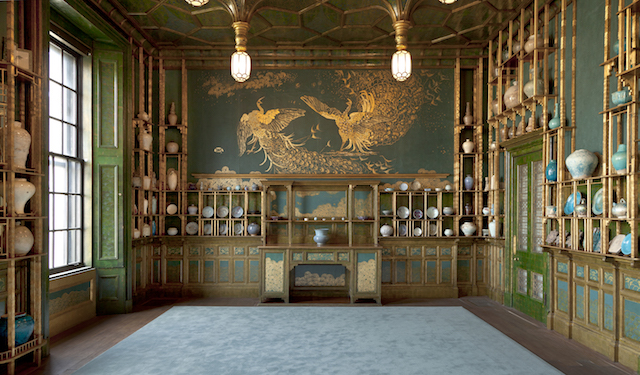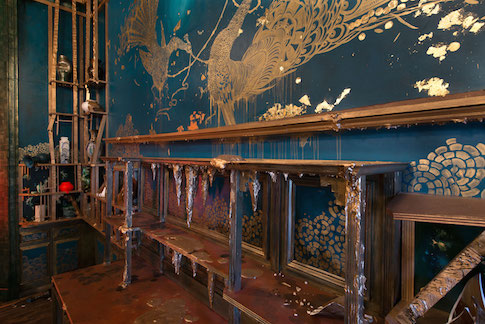Tensions between artists and the wealthy people and institutions who make their lives possible are nothing new. I expect that at Lascaux there was some sort of council of shamans exasperated at how long proto-Pierre was taking with the bull. Since its founding in 1923, among the jewels in the Freer Gallery’s crown has been a decorative installation that doubles as a monument to difficult artist-patron relations: Whistler’s "Harmony in Blue and Gold: the Peacock Room."
Whistler had been brought in by his friend and benefactor Frederick Leyland in 1876 to spruce up a room in the railroad magnate’s London home. The trouble began when Leyland left town for the summer, telling Whistler in a note, "When you have finished the dining room you had better write and let me know how much more I owe you."

If you wouldn’t say it to your mechanic, you shouldn’t say it to your painter-decorator, let alone to a relentless self-promoter like Whistler. Several months later (Leyland had been anticipating the sort of job that would take a few days) and after an exchange of increasingly unfriendly letters, Whistler presented Leyland with an outlandish, extravagant piece of decorative art, complete with gold peacocks on the shutters and a paint-job that covered expensive leather wall surfaces—and a bill for £2,000. (Those are 1876 pounds.)
In the course of their dispute over the money, Whistler, who still had access to the house, took a break from his commitment to aestheticism—art for art’s sake—and added an allegorical painting to the room’s south wall. It depicted two additional peacocks, one looking a bit down-and-out, and the other strutting and bedecked in coins, fighting it out. He called it "Art and Money; or, The Story of the Room."
Leyland was un-amused, as he was at the fact that Whistler had been hosting critics and the press in his home during the course of the work, not to mention that Whistler was rumored to be enjoying inappropriate relations with Mrs. Leyland. Whistler ended up with £1,000, a stern admonition to never again set foot in the house, and a promise that Leyland would horse-whip him in public should he ever be seen with the missus again. Whistler fired back with an ugly, rather silly caricature of Leyland as a monstrous peacock hunched at a piano and using Whistler’s house as a bench, called "The Gold Scab: Eruption in Frilthy Lucre"—the apparent misspelling a lame play on Leyland’s full name. Whistler then lost that painting to creditors in bankruptcy proceedings.
The artist died decades later without having seen his dining room again. Interestingly, Leyland kept it more or less as is, and used it to display his collection of porcelain, as had been the plan from the outset. After Leyland’s death, Charles Freer bought the room, shipped it to Detroit, and used it to display his own rare pots and vessels, finally bequeathing it to the Smithsonian.
The rest would be history but for recent efforts to revive interest in the room: In 2011 the Freer restored it to its 1908 appearance, and this summer imported from Boston a contemporary installation, "Peacock Room REMIX: Darren Waterston’s Filthy Lucre." The contemporary work will be on view through next year in the neighboring galleries of the Sackler, but as the Freer is closing for renovations at the New Year, and thus the original Peacock Room will be offline, it is worth visiting now when the two installations are viewable together.
Waterston’s work is a recreation of the Peacock Room, wherein the space appears to have been simultaneously the scene of a smash-and-grab, some sort of forcible compression (the ceiling is obviously lower than in the original room), and exposure to an alarming element that can melt the color gold. As an act of surrealist craftsmanship it is really very good, and the skillful mimicry and simulated destruction of some of Whistler’s details is impressive. Gold paint "bleeds" out onto the floor. The "Art and Money" is now a more violent affair involving peacock evisceration. La Princess du pays de la porcelain, who hangs winsomely on the north wall of the original, has had her face smudged out. Smashed pots lie on the floor. Putting the whole thing together must have been fun in the way that knocking over blocks is fun for a kid.

Less impressive is the apparent effort at immersion for the viewer: red light, looking as though it were projected on a scrim by a high-school theater crew, comes in through the partially-opened shutters. Spooky noises—jarring chords, whispers—are piped in via unseen speakers. The effect is humorous, and I fear not in the way Waterston and his team intended.
The gallery’s materials describe the exhibit as a reimagining of the Peacock Room in the form of "a decadent ruin collapsing under the weight of its own aesthetic excess." This is the kind of work that inspires critics to intone things like, "Filthy Lucre is a welcome participant in the long conversation about the curious dance of art and money," or "a powerful statement" on the subject—without specifying exactly what the meaning of the statement precisely is, as the metaphor would seem to demand. The curators, citing Waterston, express it as an assertion of fashionable liberalism:
The artist sees a profound parallel in the culture and attitudes that produced the Peacock Room and those of our own time, which is likewise defined by both great wealth and dramatic income inequality (with the richest 1 percent of Americans taking home 19 percent of the country’s income and the number of people living in poverty rising to 46.5 million).
The footnote to that passage, from the exhibit catalogue, cites Thomas Piketty—natch. One finds oneself relieved that the installation isn't simply a rehash of Whistler's original, angry complaint: a hit on philistine donors on behalf of True Artists. It is quite clear that Waterston intends his piece as a swipe at least as much at Whistler as at Leyland, and implicitly at the self-promoting marketing superstars of today’s art world, like Damien Hirst. As an intellectual effort, then, it is at least two-dimensional.
What, then, are we left with? Money corrupts, it seems, especially in the Gilded Age and again now. I find this banality less interesting than what the existence of Waterston's installation (which required a fair amount of private fundraising, in addition to museum support) suggests about the patrons of today's art world. For all their belief in progress, they are happy to underwrite art that is, in essence, a manifestation of secularized Christianity: a morality tale about the sinfulness of wealth.
